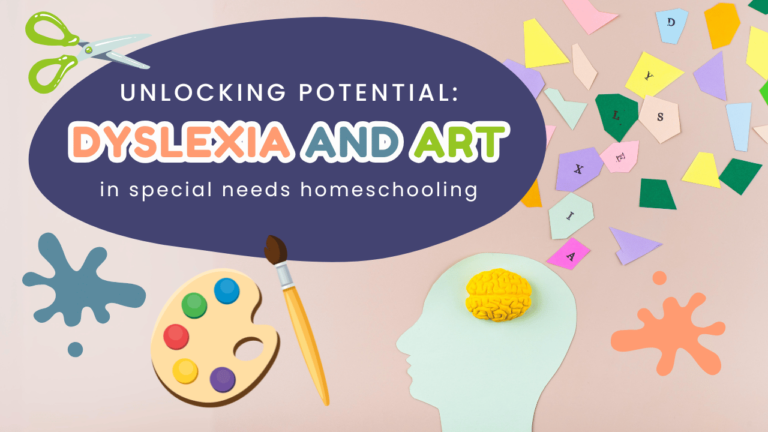Reading is often a daunting challenge for kids with dyslexia, and traditional educational methods often fall short of addressing their unique needs. Yet typically, dyslexia comes with amazing strengths in sports and creative arts. Welcome to the transformative realm where homeschooling meets the liberating power of art, a place where creativity becomes the key to bridging the gap between struggle and success.
Incorporating art into homeschooling for kids with special needs, particularly those with dyslexia, may sound unconventional, but it’s an approach grounded in both science and practice. Art offers an alternative avenue for expression and comprehension, providing a respite from the relentless frustrations of traditional learning. Through painting, drawing, music, and other artistic forms, children can explore their strengths, build confidence, and develop skills in ways that align with their natural inclinations. The integration of dyslexia and art in homeschooling doesn’t just make education accessible; it transforms it into a vibrant, inspiring journey tailored to each child’s unique gifts. Dive into this innovative approach and discover how art can illuminate the path to learning for special needs kids.
Understanding Dyslexia: A Unique Learning Challenge
Dyslexia is a learning disorder that affects the way individuals process language. It is characterized by difficulties in reading, spelling, and writing. For children with dyslexia, traditional educational methods may not effectively address their specific needs. However, by incorporating art into homeschooling, parents and educators can provide a more inclusive and engaging learning environment.
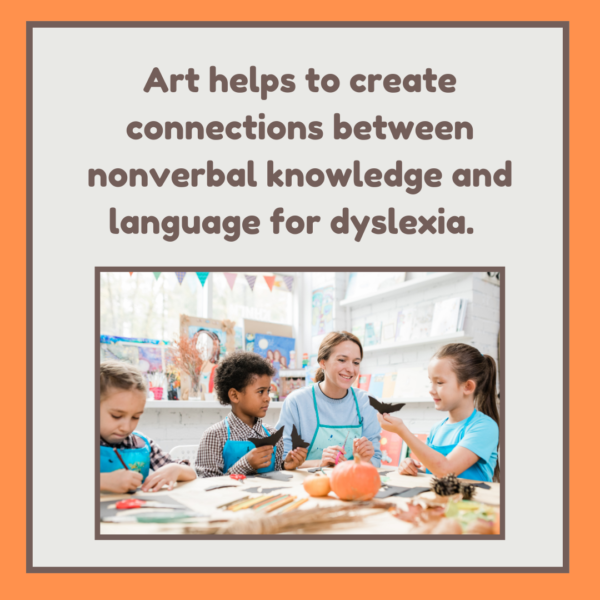
Art offers a unique way for dyslexic learners to express themselves and understand concepts. Through visual arts such as painting or drawing, children can explore their creativity and develop their cognitive skills. Art allows them to communicate their thoughts and ideas in a non-verbal manner, which can be particularly beneficial for those who struggle with reading or writing.
Moreover, art provides a multisensory experience that engages different parts of the brain. This holistic approach to learning can help dyslexic learners make connections between different subjects and enhance their overall understanding. By integrating art into homeschooling curricula, parents can tap into their child’s strengths and provide them with the tools they need to succeed.
The Power of Art in Education: A New Perspective
Art has long been recognized as a powerful tool for education. It encourages creativity, critical thinking, and problem-solving skills – all of which are essential for success in today’s rapidly changing world. When it comes to homeschooling children with special needs like dyslexia, art takes on an even greater significance.
Art provides an alternative approach to learning that goes beyond traditional academic subjects. It allows children to engage with their surroundings in a meaningful way and encourages them to think outside the box. Through artistic activities such as painting or sculpting, dyslexic learners can develop important skills such as spatial awareness, visual perception, and fine motor coordination.
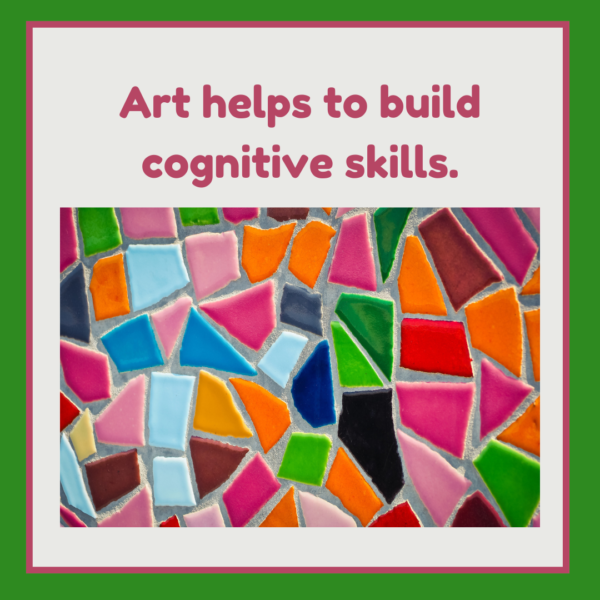
In addition, art fosters self-expression and boosts self-esteem. For children with dyslexia who may struggle with traditional forms of communication, art offers a safe and non-judgmental space to express themselves. This can have a profound impact on their overall well-being and confidence.
Breaking Barriers: How Homeschooling Empowers Special Needs Kids with Dyslexia
Homeschooling provides a unique opportunity for parents to tailor their child’s education to their specific needs. For children with dyslexia, homeschooling can be particularly empowering as it allows them to learn at their own pace and in a way that suits their individual learning style.
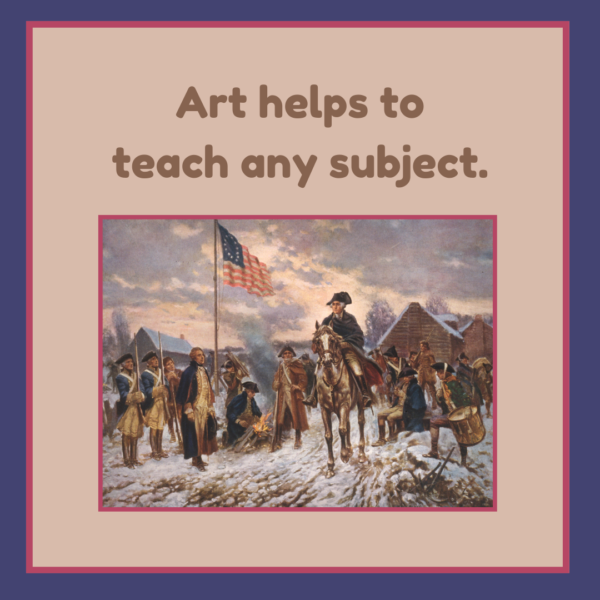
By incorporating art into homeschooling curricula, parents can further enhance the educational experience for their dyslexic child. Art provides a flexible and adaptable medium through which children can explore different subjects and concepts. Whether it’s using colors to understand emotions or creating visual representations of historical events, art allows dyslexic learners to engage with the material in a way that makes sense to them.
In addition, homeschooling provides a supportive environment where children can feel comfortable taking risks and making mistakes. This is especially important for dyslexic learners who may have experienced frustration or embarrassment in traditional classroom settings. By embracing art as part of the homeschooling journey, parents can create an inclusive and nurturing space where their child’s unique abilities are celebrated.
Creativity as a Tool: Enhancing Learning Through Art
Creativity is often seen as an innate talent reserved for artists or musicians. However, when it comes to education, creativity is a valuable tool that can enhance learning for all students, including those with dyslexia.
Art encourages children to think outside the box and approach problems from different angles. It fosters innovation and helps develop critical thinking skills. By incorporating art into homeschooling, parents can tap into their child’s creative potential and provide them with a well-rounded education.
Moreover, art allows dyslexic learners to engage with their strengths. Many dyslexic individuals have exceptional visual-spatial skills and a keen eye for detail. By incorporating art activities into their homeschooling routine, parents can harness these strengths and help their child thrive academically.
Art Therapy for Dyslexia: Healing Through Expression
Art therapy is a form of therapy that uses artistic expression as a means of communication and healing. It has been shown to be particularly effective for individuals with dyslexia, as it provides an outlet for self-expression and emotional processing.
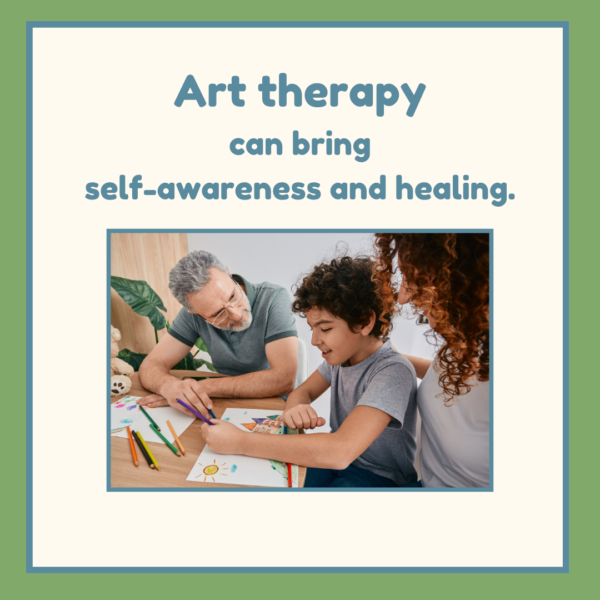
Through art therapy, dyslexic learners can explore their thoughts and feelings in a safe and supportive environment. They can use colors, shapes, and textures to express themselves in ways that words alone cannot capture. This can be especially beneficial for children who struggle with verbal communication or have difficulty expressing their emotions.
In addition to its emotional benefits, art therapy also helps improve cognitive skills such as attention span, memory, and problem-solving abilities. By engaging in artistic activities that require focus and concentration, dyslexic learners can strengthen these cognitive functions and improve their overall learning abilities.
Nurturing Confidence: Building Self-Esteem through Art
Children with dyslexia often face challenges that can impact their self-esteem. They may feel frustrated or discouraged by their difficulties in reading or writing. However, by incorporating art into homeschooling, parents can help build their child’s confidence and self-esteem.
Art provides a non-judgmental space where children can explore their creativity without fear of failure or criticism. It allows them to take risks and make mistakes without the pressure of getting things “right.” This freedom to experiment and explore can have a profound impact on their self-confidence.
Moreover, art offers tangible evidence of progress and growth. Dyslexic learners can see their skills improve over time as they create more complex and detailed artworks. This sense of accomplishment can boost their self-esteem and motivate them to continue exploring their artistic abilities.
Individualized Education: Tailoring Curriculum to Strengths
One of the key advantages of homeschooling is the ability to tailor the curriculum to each child’s individual strengths and needs. For children with dyslexia, this individualized approach is crucial for their academic success.
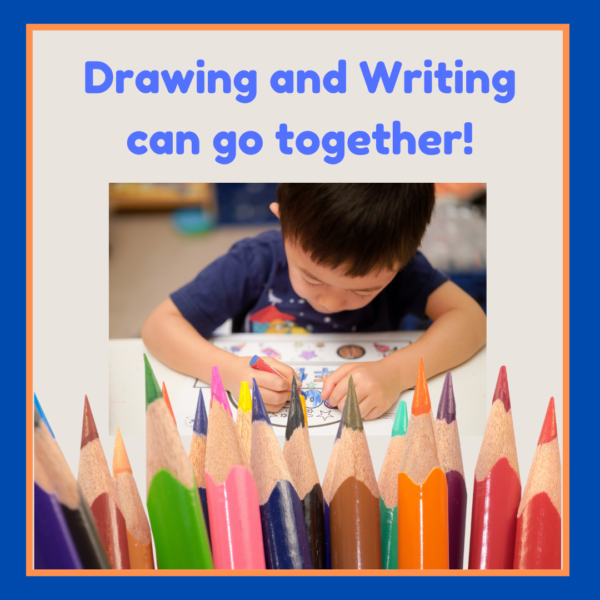
By incorporating art into homeschooling, parents can create a curriculum that aligns with their child’s strengths and interests. Whether it’s dedicating more time to artistic activities or using art as a tool for understanding other subjects, such as history or science, parents can customize the learning experience to suit their child’s unique needs.
This individualized approach not only enhances learning but also fosters a sense of ownership and empowerment in dyslexic learners. By actively participating in shaping their education, children with dyslexia develop a stronger sense of agency and become more engaged in the learning process.
Overcoming Obstacles: Art-Based Strategies for Dyslexic Learners
Dyslexia presents unique challenges when it comes to learning. However, by incorporating art-based strategies into homeschooling, parents can help dyslexic learners overcome these obstacles and reach their full potential.
Art provides a multisensory experience that engages different parts of the brain. By incorporating visual elements into lessons, such as diagrams or illustrations, parents can enhance comprehension and retention for dyslexic learners. Additionally, using color-coding or visual organizers can help dyslexic learners organize information more effectively.
Furthermore, art-based strategies can help dyslexic learners develop phonological awareness, which is crucial for reading and spelling. By incorporating activities that involve sound and rhythm, such as music or poetry, parents can help dyslexic learners strengthen their phonological skills in a fun and engaging way.
Celebrating Progress: Milestones in Homeschooling with Art
Homeschooling with art offers a unique opportunity to celebrate the progress and milestones of dyslexic learners. Art provides tangible evidence of growth and improvement, allowing parents to track their child’s development over time.
Parents can create a portfolio of their child’s artwork, showcasing their creativity and artistic skills. This portfolio not only serves as a visual representation of progress but also as a source of motivation and pride for dyslexic learners.
In addition to personal portfolios, parents can organize art exhibitions or showcases where dyslexic learners can display their artwork to family and friends. These events provide an opportunity for children to share their achievements with others and receive recognition for their hard work.
By celebrating the milestones achieved through homeschooling with art, parents can instill a sense of accomplishment and pride in dyslexic learners. This positive reinforcement further motivates them to continue exploring their artistic abilities and embracing the transformative power of art in education.
Grab your FREE e-book guide to revamp your homeschool for success!
Are you new to homeschooling, or just wanting a fresh start? Download our FREE “How to Homeschool in 6 Easy Steps” guide and get valuable insights from Sue’s 30+ years of experience as a special educator and homeschool mom of 4!
Want to know about new products and blogs?
Join our email newsletter to be the first to know about a new homeschool and special needs blog, and new products from our shop! Sign up for only the newsletter, or grab your FREE “How to Homeschool in 6 Easy Steps” guide and you will also be added to the newsletter!
Also, join our Facebook group!
Join our new “Homeschool Help for Special Needs” Facebook group! It is a place for homeschool moms to ask questions about homeschooling a child with special learning needs, share teaching and curriculum ideas that have worked (and those that bombed), and be real about the unique challenges of homeschooling with special needs. If you want to join us, be sure to answer the member questions to help us keep this private group secure. Join us now!
